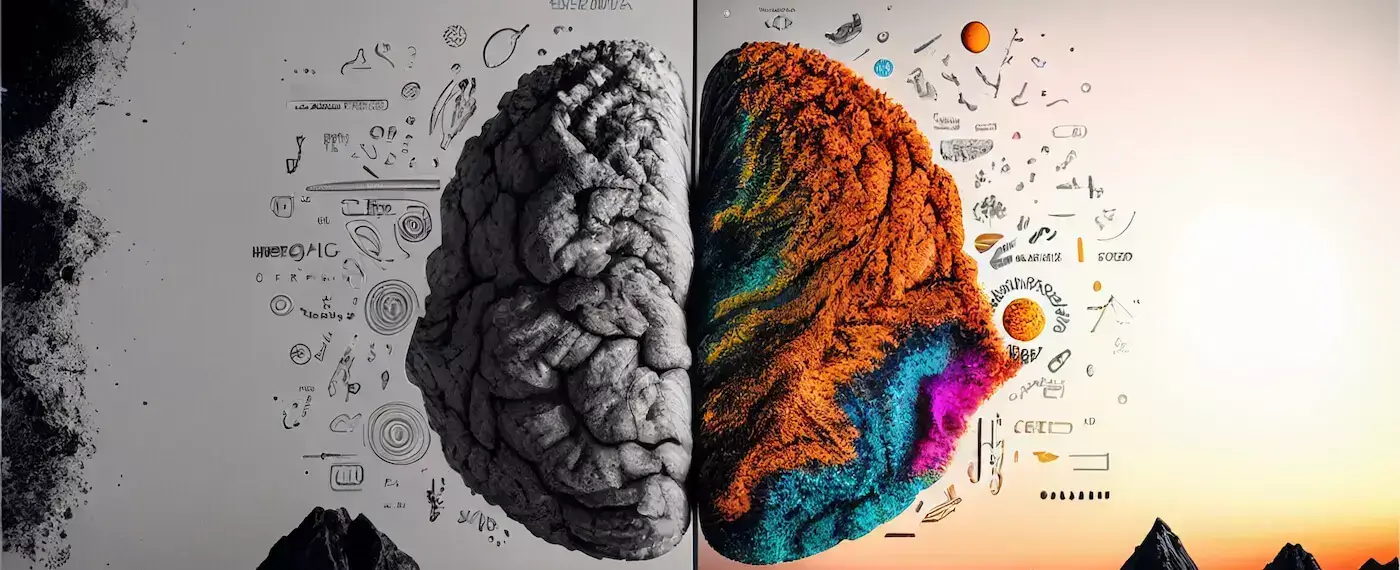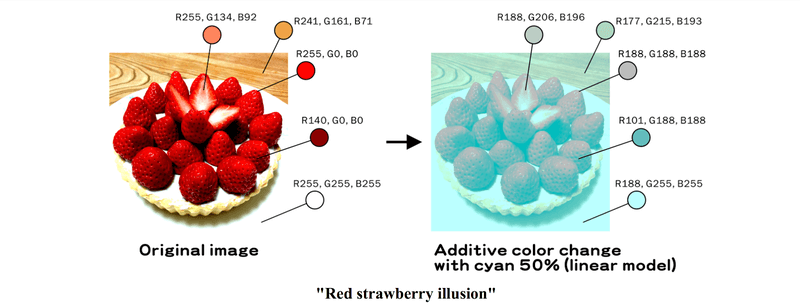
Brain Color – it’s not Always Rainbows and Butterflies
Table of Contents
The human brain color physically is white, black, and red-pinkish while it is alive and pulsating. Images of pink brains are relative to their actual state. The brains seen in movies exhibit white, gray, and yellow shadows because they are disconnected from the blood and oxygen flow.
What Color is the Brain?
Sitting here and looking around, when I started thinking, what color is my brain? Is the brain a pink color, or the colors only exist in my actual mind itself? A play of light and shadows inside and out, if you could put it that way.
The human brain is the organ that colors objects we perceive with our eyes and has a color of its own. Only that color is recognized by the brain as well. Like a tongue twister, one could say, but simply – bland gray, dull pinkish, chalky black, black, and hues of red. A pulsating, living brain will have the flow of oxygen, blood vessels, nerve fibers, and many other things that many may consider not so pretty to look at.
The brain is one of the most extraordinary organs in the human body. The human brain controls the central nervous system, with the help of it, we walk, talk, breathe, and think. The human brain is very complex, the number of its neurons reach 100 billion. The complexity of brains is so immense that many studies based on it have to intertwine. So, most likely, if you aren’t studying medicine or weren’t just sitting around like me and thinking what color is your brain, the question would just dash on by quickly in the abyss. The human body might have all the colors of a rainbow, blood is red, bones are white, and so the list goes on and on. You have probably seen a brain immersed in some form of alcohol or gel in the movies. In the majority of cases, color appears to be white, gray or having a yellow shadow. Those are true but an alive and pulsating brain, in reality, is not just gray – it’s also white black and red.

When the Human Brain is Alive
When the human brain is alive, it can be considered pink, simply put. Though, not that simple, so let’s just make it a little bit more confusing mentioning a live brain is about 40% made up of “gray matter,” 60% of “white matter.” Nonetheless, these two terms will not be a pinpoint on color description, considering our visual perception. Bare with me, once dissected into thin hairs, white and gray matter will constitute different brain tissue. Gray matter consists of those cells where “factual grounding” of information takes place. This process will take up about 94% of all the oxygen that our brain uses. The white matter consists of fatty proteins, in other terms, called myelin. Myelin is a substance that covers, surrounds fibers extended from the main body of a nerve cell or neuron. Using different terminology, this is our brain’s communication net, connecting different parts of gray matter, and also the gray matter itself, being in connection to the rest of the organism. A quite fitting analogy would be one made with a computer, who are the gray matter – the processor, and the white matter – electric wiring.
Men are from Mars, and women are from Venus. That got your attention quick… Before I further continue, the intellectual outcome between men and women will be the same, but the waypoint of intellect is reached might differ. It would be fantastic if we could learn more from each other. Scientists brought in two groups; men and women, with the same exact IQ. Fascinating discoveries were made while scanning their brains; it appeared to be that the brains of men had 6.5 times as much gray matter as compared to women. The woman’s brains, though, had almost 10 times as much of white matter. Furthermore, the white matter in women’s brains appeared to be most in the frontal lobe, while men had virtually none. This is extraordinary because the frontal lobe, as scientists predict, holds the critical function in the control of emotions, building one’s own identity, character, and thoughtfulness. Based on the study, it does appear to be so, that women’s and men’s brains are hooked up and configured differently, but giving the same type of intellect as an outcome. Very interesting and hope to find more studies on this.
Color Constancy, So is the Brain Pink?
What would you say a japanese man and strawberries have in common? Akiyoshi Kitaoka created an image (as seen below) which contains no red pixels. One, however cannot just stop seeing those juicy red strawberries. Yum!

Color Constancy
Color constancy is perceptual constancy with which we perceive an object to be, in lit areas and darker ones – the red strawberries are just red. The fine lines of a person’s ability to interpret light, which entails that the perceived light of an object stays relatively similar to the change in illumination. Color constancy is a subjective constancy and a feature of the way humans see color. Color changes based on the play between light and shade. Light and shadow, that’s all it is. Optical illusions left and right; we scream without seeing for what it is. Well, sometimes, all you can do is just look at it.
After posting his image to Twitter, Akiyoshi Kitaoka, somewhat went viral and people began to question perceptions of visual colors. So look for yourself, the color of these strawberries might be up for debate. Just how we perceive pink to be pink in an active human brain. So, a more in depth philosophical answer to the question, will still be a relative one. Be brave and take a guess what color the strawberries are, look into the illusion from the professor in psychology Kitaoka. At first, this might seem like a badly exposed image, but it happens to most of us in post production. It’s actually even more startling when we find out that the picture has 0 red pixels. Turns out the red in the strawberries, only exists in our brain. The blue faint filter is overridden by our brains program to perceive these strawberries as red.
Okay-okay, cannot keep on hiding the answer in my sleeve. Check out the image below so we can breathe out.

There you have it, just a quick test to illustrate that the programs running in our brains often take shortcuts for the betterment of our survival. This is to show that the color, as mentioned earlier talk, could all be a trick based on past memories. Most of us are subject to it and cannot go argue about every hue of color that we perceive. Maybe that is what made all those famous artists different. The lights in their head reflect differently, giving us their original mixes of color, passing their felt initial emotions. Maybe that is the beauty of humanity, not confining ourselves to one certain standard, to one specific color perception. Seeing that the difference in the gray and white matter will still produce the same type of intellect. These colors exist in our brains while we try to pinpoint the colors that makeup brain matter. Turns out to be a pretty amusing story.
From this relative point perspective, scientists say that the brain is pink with hues of brown. In an alive brain, not like the transferred brain of Frankenstein, the exterior of our brains are pretty much identical. The capillaries are delivering oxygen to the brain 24/7, the mix between red/purple blood with oxygen gives off a pinkish hue. Without oxygen the brain won’t survive a long time. Playing around with science-fiction, in Frankenstein’s case most of his memories would have been wiped out due to the lack of oxygen. Pinkish-gray in layman terms.
Brain Color Test
Around the year 2015, the whole world plunged into a discussion as to what color is the dress. After being posted to a social networking service, Tumblr, the image was mentioned more than 10 million times in tweets. The division of two camps began with the first proclamation saying, the dress is white and gold, while the other camp stated that the dress is blue and black. It was fascinating to see the discussions going on at the dinner table. You surely have to try it for yourself.

After the Debate Died Down
Neurobiologists dove into the study of this viral image. Digging into the core that made people perceive the difference in color. Pascal Wallisch from NYU with a Ph.D. in Neuroscience furthered his interest in it and asked 13000 people on the internet what color was the dress and how it is illuminated. Also, wherever it “held onto the light” or rather “came out of shade.” Between the respondents, there were some that saw the dress in one color and then another, it kept on switching for them. For the rest of the contributors to the study, it seemed like the hypotheses, as suspected, divided into two camps. With a new edition now, those that saw the dress coming out of shade thought it to be white and gold; those that saw the dress coming out of the light perceived it to be black and blue. Nonetheless, it looks like we won’t find the truth about this dress because one out of every five respondents, which said the dress is coming out of the shade, still perceived it to be black and blue.